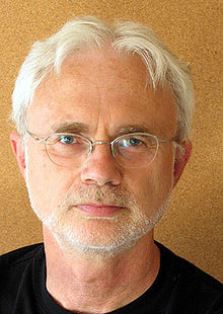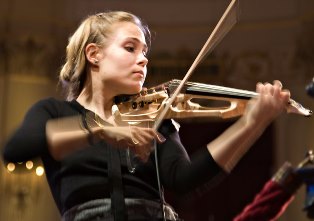
Adams' "Scheherazade.2" Resonates with the CSO

Saturday night’s Cincinnati Symphony Orchestra concert at
Music Hall was, in the words of composer/guest conductor John Adams, “full of
images.” They ranged from a small “watercolor,” Anatoli Liadov’s seven-minute
“The Enchanted Lake” (1909), to Adams’ own “Scheherazade.2,” a four-movement work
for violin and orchestra, heard in its CSO premiere. Also on the program was
Ottorino Respighi’s quintessential set of musical postcards, “Pines of Rome.”

Guest artist in “Scheherazade.2” – the title sounds like “a software update” said Adams -- was violinist Leila Josefowicz in a blazing and self-realized performance that brought the legendary Persian heroine to life. (The work was given its world premiere by Josefowicz and the New York Philharmonic led by Alan Gilbert in March.)
Adams wrote “Scheherazade.2,” he said, as a protest against male brutality towards women. In the “Arabian Nights” original, Scheherazade is the latest of the king’s victims, doomed to be killed after spending one night with him. Instead, she tells him a riveting story, thus saving her life until the next night. This pattern is repeated for 1,000 nights, by which time the king has fallen in love with her and decides to make her his queen. In Adams’ 45-minute work, which he describes as a dramatic symphony, Scheherazade is represented by the violin.
“Scheherazade.2,” which was re-positioned to close the concert rather than ending the first half -- falls into four, loosely programmatic movements, each with an evocative title: “Tale of the Wise Young Woman – Pursuit by the True Believers,” “A Long Desire (Love Scene),” Scheherazade and the Men with Beards” and “Escape, Flight, Sanctuary.” This is not post-minimalist John Adams, but a complex and hugely colorful blend of modern and post-romantic style. Adding a distinctive hue to the orchestra was the cimbalom, or hammered dulcimer, performed by Chester Englander.
In her first entrance in the opening movement, Josefowicz climbed high into the violin’s upper register. The mood of the music was bright and assertive, growing more lyrical as it went along. As the “true believers” dispute with Scheherazade, the orchestra grew more strident and snarly, and it ended with a bang. The protagonist violin remained above it all, however.
The second movement began passionately with a long orchestral passage that cut off suddenly before heading into dreamier territory. The violin’s entrance was soft and warm over long-held notes by the CSO. This was not love without a struggle, however. The orchestra answered the violin ardently, and she returned their advances in kind until they united in a long tender passage and the music came to an almost languorous end.
“Scheherazade and the Men with Beards” opened with lots of brass and mallet percussion. It proceeded in question-and-answer fashion, with anger and insistence in the orchestra -- including a long harangue at one point -- invariably answered coolly and quietly by Josefowicz on the violin. After a passage of wild scraping by the orchestral violins, she offered one last word, as if in disgust.
“Escape, Flight, Sanctuary” opened with surging figures and considerable intensity in the CSO. The violin entered energetically, growing very virtuosic as it proceeded, very much evocative of flight and struggle. There was a release of tension by both Josefowicz and the CSO and the music grew more chordal and hopeful, with a big sustained passage for the orchestra, followed by quiet. The violin entered tentatively here, as if searching, and the movement ended on a high note by Josefowicz. Audience response was enthusiastic and evoked a lengthy standing ovation.
Respighi’s technicolor work, which came just before intermission, was a crowd-pleaser, too. “The Pines of the Villa Borghese” brimmed with effervescence. The shouts of children (deliberately dissonant) gave way suddenly to “Pines Near a Catacomb.” The chant-like spell of this movement was well crafted by the low strings and brass, and principal trumpeter Matthew Ernst delivered an austere solo from the Music Hall foyer. The sound of the piano (Michael Chertock) led into “The Pines of the Janiculum,” which featured a splendid solo by principal clarinetist Jonathan Gunn, and was capped by the eloquent (taped) sound of birdsong.
“The Pines of the Appian Way” began softly and grew into a full-bore march, abetted by additional brass choirs placed in the left and right balconies. It came to a pounding, resounding conclusion, which also drew the (near-capacity) audience to their feet.